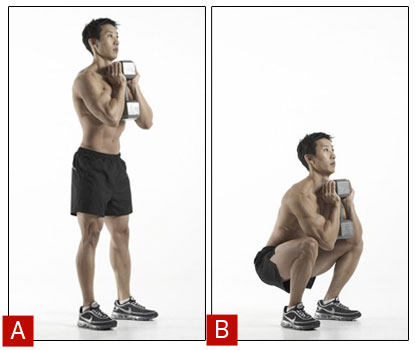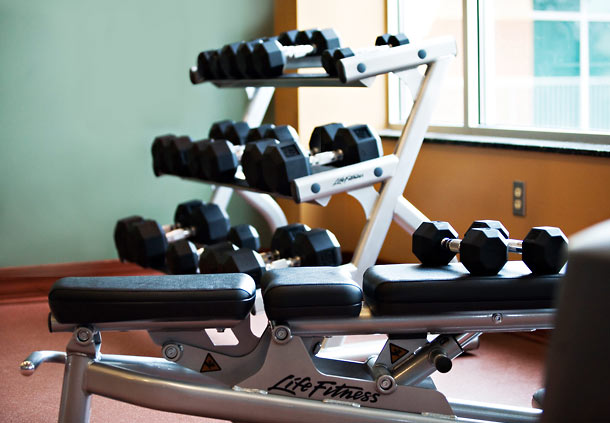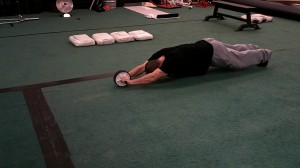SAPT Exercise of the Week: Goblet Squat to Stepback Lunge
Here's a cool hybrid exercise that will work your lower body and smoke your core as well.
Goblet Squat to Stepback Lunge
How to do it: Pretty self-explanatory. Grab one or two kettlebells and hold them in the goblet or "racked" position as shown in the video. If you don't have kettlebells, hold one dumbbell at your chest as shown in the picture below.
One squat followed by a stepback lunge with each leg equals one rep. Perform 5-12 reps, depending on your goals.
 Why I like it: I find this exercise to be useful for a few scenarios:
Why I like it: I find this exercise to be useful for a few scenarios:
1) Travel. It's no surprise to most of you reading that hotels aren't the best-equipped when it comes to their "fitness rooms." The first thing you'll notice is the lack of a squat rack (which would cost less than the myriad machines they have, along with providing countless more uses, but I digress). You'll then quickly notice a bunch of treadmills, machines, and, if you're lucky, a dumbbell rack.
 However, more often than not, the dumbbells stop at 50lbs. This is all well and good....I get why they do that. Nonetheless, sometimes those who are a bit stronger run out of ideas with what to do with sub-55lb dumbbells besides doing thirty reps of everything. Since the goblet squat to stepback lunge demands more from you than performing a squat (or stepback lunge) on its own, you can get more out of the lighter dumbbells. Also, with the weight being held at your chest, your entire midsection is going to have work like crazy to keep yourself upright.
However, more often than not, the dumbbells stop at 50lbs. This is all well and good....I get why they do that. Nonetheless, sometimes those who are a bit stronger run out of ideas with what to do with sub-55lb dumbbells besides doing thirty reps of everything. Since the goblet squat to stepback lunge demands more from you than performing a squat (or stepback lunge) on its own, you can get more out of the lighter dumbbells. Also, with the weight being held at your chest, your entire midsection is going to have work like crazy to keep yourself upright.
Another note here would be if you're in a normal gym with only a few minutes to train and the squat rack is being hogged by a dude doing shrugs for an hour.
2. To use on an "off" day. The more I train, the more I tangibly recognize the truth of Dan Gable's sage advice: "If something is important, do it every day."
Wanna know something that's important? Squatting! Toss in a few of these babies on your off days to get some bloodflow going, "unglue" yourself after a long day at the office, and ingrain some proper motor patterns.
Not to mention, the stepback lunge is the most "knee friendly" of all the lunge variations, on top of the fact that it doesn't typically invoke too much post-workout soreness due to lessened deceleration demands (as you'd experience during a forward lunge or walking lunge).
If you are using these on an off day, go light with the weight selection. No need to be a superhero, big guy.
3. Accessory Work. We've also programmed these for people as part of their main training day, for a few reasons. Maybe we're trying to give their CNS a break from the barbell (ex. if they're overwhelmed with in-season demands or are doing a lot of extra work outside SAPT with the military, their sports teams, etc.). Or, sometimes, we're just trying to deload their spine a bit and take some time away from barbell squatting/lunging. Or, maybe we just want to make them hate life.
4. Conditioning Work. As noted above, these things have the potential to make you hate life. Toss them in from time to time to develop that good ol' work capacity.
**Addendum: This also makes a great variation for sandbag work. See the video below in which me and a few buddies of mine did these for part of an outdoor workout.
5 Quick & Random Training Tips
1. How and when you do your abdominal training in a given week is actually fairly important. For example, if you decide to do standing rollouts 24-48 hours before a heavy deadlift session, chances are your deadlifts are going to suffer greatly, and perhaps even be risky to attempt (it will be much more difficult to stabilize your lumbar spine).
 This is because rollout variations place incredible eccentric stress on the anterior core, inducing large amounts of soreness and requiring a longer recovery period. The only caveat to this rule would be if your name is Ross Enamait.
This is because rollout variations place incredible eccentric stress on the anterior core, inducing large amounts of soreness and requiring a longer recovery period. The only caveat to this rule would be if your name is Ross Enamait.
Other abdominal programming faux pas I can think of would be pairing an anterior loaded barbell variation (i.e. front squat or zercher grips) with an ab exercise, and/or placing a hanging leg raise before or alongside a farmers walk. The former is a blunder because anteriorly loaded barbell movements already place considerable demands on the core musculature; the latter isn't the greatest idea because your grip endurance is going to become an issue. Spread them apart to receive the maximum benefit of each.
2. If squatting is problematic for you, you don't need to force it. At least not initially. While the squat is a phenomenal movement and undoubtedly should be a staple in one's strength and conditioning program, I'm finding that more and more people need to earn the right to back squat safely, much like the overhead press. This may be due to structural changes (i.e. femoroacetabular impingement) or immobility (i.e. poor hip flexion ROM or awful glenohumeral external rotation and abduction).
If this is the case, simply performing a heavy single-leg movement as the first exercise in the session will work perfectly. You can use anything from forward lunges to bulgarian split squats, but my favorite is probably the barbell stepback lunge with a front squat grip.
You're still receiving the benefits of axial loading due to the bar position, you can still receive a healthy dose of compressive stress in your weekly training (if you're deadlifting), and yes, you'll still be exerting yourself. I recommend performing these in the 3-6 rep range to allow for appreciable loads.
And, keep in mind, when I said "if squatting is problematic" at the beginning of point #2, I was referring to structural, mobility, and/or stability abnormalities that may make it unsafe for you to squat for the time being. I wasn't, of course, implying that if it's "just too hard" that you shouldn't do it. There's a pretty thick line between one being contraindicated for an exercise and someone who's simply unwilling to to do a lift because it takes mental+physical exertion.
3. If your wrists bother you while doing pushups, try holding on to dumbbells. It will take your wrist out of an extended position into more of a neutral one, greatly reducing the stress on that joint.
 I also like holding on to dumbbells because they allow you to use a "neutral grip," thus externally rotating the humerus, giving your shoulder more room to breathe.
I also like holding on to dumbbells because they allow you to use a "neutral grip," thus externally rotating the humerus, giving your shoulder more room to breathe.
4. Think twice before consuming dairy as your pre-workout fuel. This may seem obvious, but frankly I still talk to people who consume cereal before a morning workout, or down milk shortly before an evening training session. Your stomach isn't going to like this while doing chest-supported T-Bar rows, anti-extension core variations, or anything for that matter.
Another tip: don't shove a bunch of doughnuts down your pie hole before training. I thought this one would be no-brainer, but I actually had a kid vomit after pushing the prowler at a sub-maximal intensity. Upon asking him what he ate beforehand, he said, "Umm, well nothing all day, and then I ate a bunch of doughnuts before coming here." Fail.
5. Figure out for yourself what training split is best for you personally. For example, I feel that training upper body the day before lower body affects me (negatively) more than if I do it the other way around. However, I know others who feel the exact opposite. Also, for those of you who utilize a bodypart split, and train deadlifts on "back day," be sure to take into consideration when and how you'll do squats on "leg day," due to the beating your spine will receive from both exercises.





